Monday, December 26, 2005
Wednesday, November 23, 2005
We are Ninja, Not Geisha
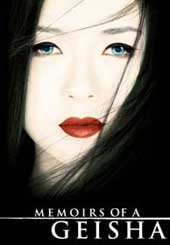
I have a confession to make. I hated "Memoirs of a Geisha" when I read it several years ago, when the novel by Arthur Golden was released in paperback. At the time, it seemed that everyone around me was also reading it, and gushing praise upon it. So, reluctantly, I held back, biding my time until I finally couldn't stand it anymore, and I let loose. My rants focused primarily on the sexual themes of the book, and (not wanting to give away details to those who haven't read it), my belief that they were inappropriate for the subject matter. It seemed to me (and continues to seem) counterproductive in a book that's supposed to help overturn the West's preconceived notions about "geisha" being synonymous with "prostitute"... that there is so much attention paid to the sexual lives of these women, up to and including prostitution. However, it was after reading one particular scene that I was sent over the top; a scene which backed up every Westerner's stereotypical idea of the Japanese man as sexual pervert. Finally, I had to speak up to my reading circle friends, and come clean with my opinions. Amazingly, they still defended it, chocking it all up to the "wonderful sensuality" and allure and, believe it or not, "romance", that they perceived in the tale.
Slowly though, more of those around me came around, as stories began to come out from Japan. Apparently, the book proved none too popular when the translated version hit the bookshelves of the country where the story was set. Readers cited various reasons, mostly having to do with the translation itself, and the disquiet they felt reading this story set in their history, written by an outsider. A very talented Japanese female translator was used for the project, who went out of her way to make sure that the dialogue spoken by the characters, was accurate to the specific time, place, and niche culture of the protagonists. The affect on Japanese readers was puzzling - how could a Western man write this so well? Many ended up giving more credit to the translator than to the original author. And if you can't understand exactly what they're describing, here's an analogy: imagine if a contemporary Japanese author, were to write a novel in the time, place, and language of Jane Austen... and then this was presented to contemporary British audiences. No matter how much study and research this author did, even if the portrayal was perfectly accurate, can you honestly say that the British audience wouldn't find it a just a bit... "off"?
And so, time passed. In retrospect, we began to joke about the book, as just another, modern version of the exotic look at the "Far East" through blue and Western eyes... we moaned at its popularity and status, but otherwise it passed out of our radar. Until, of course, rumors started to fly about production of a film, first with Steven Spielberg's direction and then without, and a few murmorings about casting. Now, here we are, just weeks away from the film's release; here in LA, the billboards and commercials have already hit. Their appearance now, with all that’s going on in the world, and so many years after I had completely dismissed the book, gives off a feeling of nightmarish déjà vu. It's well known by now that the lead role will be played by a Chinese actress, and that most of the cast is comprised of just about every type of Asian except Japanese. Yunjin Kim, already a well known actress in Korea, and now a major player of the hit US TV series "Lost", turned down a role in the film in part because, well, she didn't want her big American movie break to be playing a geisha (and kudos to her). There was even a fascinating back-and-forth in the op-ed section of the LA Times a few months back, in which the filmmakers defending their casting roles, using other racist casting horrors of years past to set precedent for their actions, and basically accusing everyone who doesn't like the casting, to be racist themselves. Are you confused yet?
So you may be asking dear readers, what is the Black Moon's take on all this? Well, we won't be going to see the film, I can assure you that, and we won't sponsor the book or film via ads on this website. The only press we will give this ill-conceived film, will be negative. Perhaps between now and the release, we'll be able to list all our reasons, but I'll end this chapter of the discussion here with this open question: How many more views of "the East" do we need, through Western eyes? When do we get to hear things from their perspective, from the way they want it to be told? (comments by J.)
Tuesday, September 20, 2005
“Lost” Star Promotes Onscreen Diversity

Last year, I was pleasantly surprised to see the ABC network cast a pair of Asian-Americans on their soon-to-be-hit series Lost. Daniel Dae Kim and Yunjin Kim, both Korean-Americans, play a Korean couple shown speaking their native language only, often with subtitles, and many flashback scenes depict their life in Korea before becoming stranded on the now infamous tropical isle. Although some have criticized the characters, for reasons ranging from the quality of Daniel Dae Kim’s accent, to accusations that the characters are stereotypes; for both actors, the series has been a major breakthrough in their respective careers. It has also made actor Daniel Dae Kim an ambassador of sorts, as the series is now exported to many countries besides the United States. In a recent appearance in Toronto, Kim said, "I'm really proud of the fact that they have two Korean characters as series regulars. I'd like to do whatever I can to promote this kind of television, this kind of programming, and if I can promote diversity on television in any country, I'm happy to do it." In my viewpoint anything that gets Americans to listen to dialogue in an Asian language and make them read subtitles, has to be a good thing. (comments by J.)
Saturday, August 06, 2005
1000 Peace Doves over Hiroshima
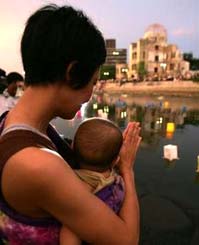
People all over the world marked August 6th, 2005, the 60th anniversary of the first atomic bombing of Japan, by rekindling a world-wide push to abolish all nuclear weapons. From Germany and India, to Australia and England - hundreds of thousands held demonstrations and commemorations that called for the dismantling of atomic arsenals. Americans in New York City drew chalk outlines on sidewalks to symbolized the hundreds of thousands of Japanese civilians who were incinerated in the nuclear bombings, and at Seal Beach, California, protestors gathered at the naval facility where nuclear weapons are stored. In actions large and small, reported and unreported - millions expressed their desire to see a world free of weapons of mass destruction. In Japan, at precisely 8:15 in the morning, the moment the bomb burst over Hiroshima 60 years ago, the city's trolleys stopped, while over 55,000 people gathered in Hiroshima's Peace Memorial Park to pray for the dead and a peaceful future. A moment of silence was held for the thousands who perished - a silence that was broken with the release of 1,000 white doves and the ringing of a bronze bell.
Tens of thousands of hand-folded paper cranes symbolizing peace, long life and health, were left on and around the simple arch-shaped stone monument that stands at the center of the park. Flowers and wreaths were placed around the monument, and hundreds brought ladles of water - symbolizing the tens of thousands who perished sixty years ago while pleading for water. Accounts from those fateful days tell of parched survivors of the atomic inferno begging for water - only to drop dead after their first sip. Outside of the only building to withstand the atomic blast, the famous A-Bomb Dome of Hiroshima, hundreds of peace activists fell to the ground to conduct a die-in that would dramatize their demand for the abolishment of nuclear weapons. Hundreds of others staged a march to demand the removal of Japanse troops from occupied Iraq. As the sun set, many thousands of small paper lantern boats were released onto the river next to the Peace Park. Each lantern held a candle, and symbolized the soul of someone who died in the atomic fire.
Hiroshima's Mayor, Tadatoshi Akiba, read a Peace Declaration for the abolishment of nuclear weapons, and criticized the United States, Russia and all the other nations possessing atomic bombs for "jeopardizing human survival." The Mayor said that "Within the United Nations, nuclear club members use their veto power to override the global majority and pursue their selfish objectives." A statement by UN Secretary General Kofi Annan, was read to the crowd at Peace Park by Nobuyasu Abe, the UN undersecretary for disarmament. Annan warned against the "cascade of nuclear proliferation" now taking place across the world. He said "we are witnessing continued efforts to strengthen and modernize nuclear arsenals", a clear swipe at the Bush administration, which is involved in developing a new class of battlefield nuclear weapons. Annan went on to say, "Today we are all hibakusha (atom bomb survivors). No nuclear weapon has been used again, and progress has been made in reducing such weapons and preventing the proliferations. But we still live in a world where tens of thousands of nuclear weapons remain - many of them on hair-trigger alert."
The Hiroshima Panels
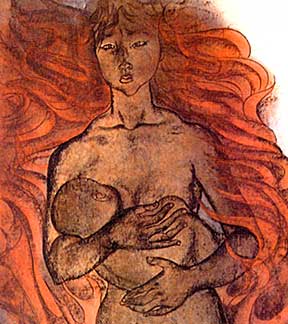
Virtually unknown in the west, The Hiroshima Panels are as profound an antiwar work as Pablo Picasso’s famous mural, Guernica. The creation of Japanese artists, Iri and Toshi Maruki (both now deceased), the panels depict the atomic holocaust wrought upon Japan when the U.S. dropped nuclear bombs on the cities of Hiroshima and Nagasaki. The monumental panels, which are actually painted upon traditional-style folding screens, took 30 years to complete, and provide a chilling look at the terror of nuclear war. The husband and wife team visited the city of Hiroshima three days after it was bombed. They carried the injured, cremated the dead, searched for food, and gathered materials to help construct shelters. Overwhelmed by the destruction they witnessed, three years passed before the couple decided to set upon the creation of artworks that would communicate to the world the need to banish nuclear weapons.
Using a poetic figurative realism partly based upon traditional Japanese aesthetics, the Maruki’s painted a series of monumental panels that graphically portrayed how the people of Hiroshima and Nagasaki came face to face with the atomic age on the 6th and 9th of August, 1945. By 1956 the artists had completed ten panels, adding two new screens; the eleventh in 1959 and the twelfth in 1968. Each of the panels dealt with specific aspects of the bombing, and were appropriately titled with names like Ghosts, Fire and Atomic Desert. The murals were no mere castigation of the U.S. for having dropped the bombs on Japan. The Maruki’s savagely criticized Japan’s own war-time militarists for being cruel imperialists, and in the panel portraying the Japanese occupation and rape of Nanking, China - all the ferocity and arrogance of Imperial Japan is laid bare. The artists also painted a panel called Auschwitz, where the Nazi atrocities committed against the Jewish people were depicted with unrelenting clarity. The Maruki’s also painted panels showing Korean forced laborers and U.S. prisoners of war as victims of the atomic bombings. One panel, simply title Crows, illustrated a grisly scene - flocks of Crows descending from the sky to feast upon dead Koreans. Painted with a traditional flourish, it is a heartrending and pitiful image. As the artists wrote, "Koreans and Japanese look alike. Mercilessly charred faces - is there any difference? Together, Asians were devastated by the bomb."
Known in Japan as, Genbaku no Zu (Hiroshima Murals), the panels brought international recognition to the artists. In 1995 the Maruki’s were recommended for the Nobel Peace Prize for their ardent creative work towards world peace. Their artworks were exhibited overseas numerous times, and a museum was established in Japan to house them in 1967. Iri passed away in 1995, and his wife Toshi, followed in 2000. The Maruki Gallery for the Hiroshima Panels is still open to the public today, and they maintain a website were you can get a glimpse of this world treasure. Part of the gallery is the actual studio were the artists worked and painted. However, in recent years attendance has been dwindling, and the gallery has put out an emergency appeal for funds so that it may continue operating. Visit the online gallery, view the works, and offer a donation to keep this vital project going (the gallery can also be telephoned at 0493-22-3266). Writer and gallery board of directors member, Teruko Yoshitake, put it this way, "The Maruki’s continued to paint, hoping to make the 21st century a period of peace. We want people to help out to ensure that the gallery continues to function as the base for anti-nuclear sentiments and protecting the peace Constitution."
Twenty years ago, the artists wrote, "We began making sketches and worked day and night, encouraged by friends of the same mind who offered to act as models. As we painted, we thought and remembered and wondered. What is a 17 year old life span to a 17-year-old? What is a three year life to a three-year-old? The 900 sketches were merged together to create the paintings. We thought we had painted a tremendous number of people, but there were around 260,000 who died in Hiroshima. If we painted for years, we could not put on paper the number killed in that one second. We prayed for the blessing of the dead and prayed that the bomb would never fall again and destroy life. With these thoughts supermost in our minds, as one painting was completed - we began another. The long lasting radioactivity and the latent effects of the bomb are still, nearly forty years later, causing suffering and death. This was not a natural disaster… that is the unforgettable horrifying fact."
Nagasaki Nightmare

August 6th, 2005, marks the 60th anniversary of the atomic bombing of Japan. August 9th, marks the bombing of Nagasaki. Those who survived the blasts became known as hibakusha (Atom Bomb Survivors), and in 1974 the hibakusha began contributing artworks to an unusual project that would preserve for the world their memories of atomic fire. The Nippon Hoso Kyokai (NHK - Japan Broadcasting Corporation), encouraged hibakusha to submit original artworks based on personal experiences of having survived the nuclear bombings. Soon thousands of drawings, paintings and woodblock prints began arriving at the offices of NHK, and an exhibition of the collected paintings and drawings was mounted at the Peace Culture Center of Hiroshima in 1975. In 1984 I had the distinct honor of organizing an exhibition of these remarkable paintings in an exhibit I curated at a venue in Venice California. I received some 30 images from Japan that had at the time, rarely been seen in the United States. Since then the NHK/hibakusha artworks have been compiled into several books and traveling exhibitions. To commemorate the first... and hopefully last atomic war, I've recently expanded the archive of hibakusha artworks I maintain on my Art For A Change website. The artworks can be viewed at: www.art-for-a-change.com/Atomic/atomic.htm
Thursday, July 21, 2005
Hong Kong Comics Festival!
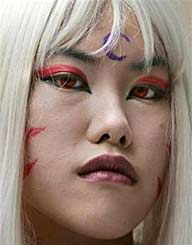
The Hong Kong Comics Festival in Hong Kong opened with a pre-party “Costume Play” competition on July 19th, 2005. The much anticipated Cosplay event attracted hordes of fans dressed up as their favorite Japanese anime or manga characters, like the lovely creature pictured above. The international press and local media went nuts photographing the flocks of otaku dressed as characters from Saint Seiya, Full Metal Alchemist, The Twelve Kingdoms, and other popular Japanese animation figures. The 7th annual ComiCon is being held at the Hong Kong Convention and Exhibition Center, and features a massive Japanese comics marketplace combined with a game fair presenting all the latest in anime related digital entertainment. The ComiCon runs from July 29th until August 2nd, 2005, and is expected to attract a whopping 450,000 attendees!
Wednesday, July 20, 2005
A Japanese Mural in Mexico
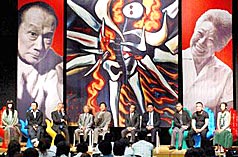
An important antiwar mural painted in Mexico by famed Japanese modern artist, Taro Okamoto (1911 - 1996), has been rediscovered after thirty five years. In Spanish the work is known as Mito del Mañana (Myth of Tomorrow), and in Japanese, Ashita no Shinwa - but like all great works of art, Okamoto’s painting speaks a universal language. The gigantic mural depicts the exact moment of an atomic bomb explosion, with the focus of the work being an anonymous human reduced to skeletal form and burning under an atomic sun.
Okamoto’s mural was originally painted in the lobby of what was to be a high-rise luxury hotel in Mexico City, but the developer encountered financial troubles that prevented the building’s completion. Okamoto’s wall painting, dismantled and put into storage, eventually disappeared - and it remained missing until just recently. In 2003 the mural was found abandoned in a yard for building materials located in a suburb of Mexico City. The Taro Okamoto Memorial Museum in Japan sent a team of restorers to Mexico to evaluate the condition of the artwork, and found that it was suffering minor damage. Calling the piece "Taro’s magnum opus", the institution obtained the rights to the mural earlier this year. The mural has been shipped to Japan where museum staff and experts began restoration work in July, 2005. Okamoto’s mural will eventually be placed on public display at the end of 2006.
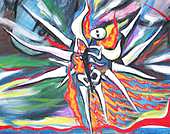
The Taro Okamoto Memorial Foundation for the Promotion of Contemporary Art released a statement that in part read, "Okamoto believed that the myths of the future develop at moments of cruelty and tragedy. This mural speaks from his deepest thoughts, from his heart." While the world’s first atomic bombing of civilian population centers occurred in August 1945 when the U.S. devastated Hiroshima and Nagasaki with nuclear fire… it would be a mistake to see Okamoto’s artwork as fixated on those terrible events. Rather, his striking mural is a warning to all humanity, and the message is more relevant today than ever before. That we’ve grown accustomed to living with a nuclear Sword of Damocles hanging above us all is really the core meaning of the mural’s title - and our continued apathy only assures that tomorrow is indeed a myth.
Painted between 1968 and 1969 and measuring some 18 feet high by 98 feet long, Okamoto’s artwork is a powerful indictment of war. While it may seem incongruous that such a disturbing and forceful work of art would appear in the lobby of a luxury hotel, one must remember that Mexican restaurants, hotels, commercial and government buildings have often made wall space available for the display of controversial large-scale public artworks. The Mexican Muralist Movement led by greats David Alfaro Siqueiros, Diego Rivera and José Clemente Orozco, set the standards for a progressive and internationalist school of art. The radical and populist artworks of these masters and the many others who worked shoulder to shoulder with them, enhance public space all across Mexico. There’s absolutely no doubt that Taro Okamoto was inspired and influenced by the remarkable Mexican school of socially conscious artists, and the discovery and restoration of his mural is cause for celebration.
Sunday, June 26, 2005
Taiko Drumming Lecture
Wednesday, May 18, 2005
Docchi no Ryori Show!
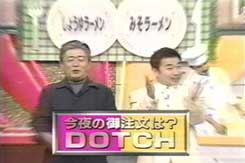
While Iron Chef presented a frenzied cooking competition that emphasized style, personality, and performance, a new cooking show already well known in Japan, places the emphasis on the art of cooking, sophisticated technique, and traditional ingredients. Docchi no Ryori Show! ("Which One!?" Cooking Show), now airing in the US as a subtitled broadcast in several major cities, is one of the greatest cooking shows ever produced. The show is hosted by Hiroshi Sekiguchi and his younger rival Yuji Miyake, whose teams of chefs prepare delectable presentations of food for the celebrity guest judges. Initially, the seven panelists are presented with two similar but different dishes that they must state a preference for, which then breaks them up into competing "Red" and "Yellow" teams. The cooks then have to sway the majority of panelists into their camp with their presentation of extraordinarily conceived dishes made from the best hand-picked ingredients. To add to the competitive atmosphere of the show, only the winning team ends up feasting upon the chosen dish, while the losing team must watch with empty bellies.
But it’s not because of the competitive nature of the show that we find ourselves tuned in every week (Saturdays at 8:00pm, here in Los Angeles). We are enthralled because each broadcast gives an in-depth examination of Japanese food, with insights into its history, production, and influence on Japanese culture. The foods prepared on each episode range from the simplest rice dishes to the most elaborate traditional concoctions, but also can focus on completely Western dishes, or Japanese-Western hybrids. Regardless of the dish however, the same care is always given to fully tantalize the audience. Camera crews will visit restaurants which specialize in the dish presented in a particular episode, and get first hand interviews and demonstrations from chefs who on a daily basis, please their clientele with their own unique version of the dish in question.
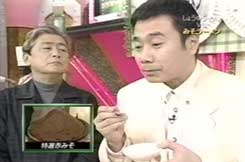
The winning stroke however, usually comes with the carefully selected "special ingredient" for each dish. Usually, this is an item made or harvested in the most traditional manner, employing practices handed down by small groups of individuals for generations. For example, types of seaweed that can only be harvested by hand at certain times of year, chicken that has been fed only the best ingredients and roam free in Japan’s misty hillsides, or a step by step look at the labor-intensive method by which Bonito fish flakes are traditionally prepared. These educational segments on the production of food, also sometimes include looks at the production of spices, the creation of kitchen implements and accessories, or whatever else is required for the team of chefs to take their dish over the top. These segments provide rare and unique looks at the traditional craft aspect of making Japanese food, and give insights into village life and age old techniques being lost in today’s fast-paced modern world. Often, even the panelists are not aware of how their favorite foods were originally produced, so the programs are as educational to them as to the viewers. There is a sense of genuine awe and deep appreciation for the remarkable lengths that the teams go to in order to create a superlative dish made from the best possible ingredients. In fact, Docchi is a one of a kind blend of history, education, and entertainment. Whether the dish at hand is French pastry, Mango Pudding, or BLT sandwiches… or Japanese fare like grilled eel, okonomiyaki, or a sumptuous noodle dish… Docchi handles it all with flare. It’s a riveting show, and we recommend that everyone tune in if the program is available in their area. When faced with any number of mediocre cooking shows versus this Japanese classic, the choice is obvious. Or as they say when the two dishes are presented for the final judging - "Docchi?!" or, "Which one will you choose?" (posted by J. & M.)

